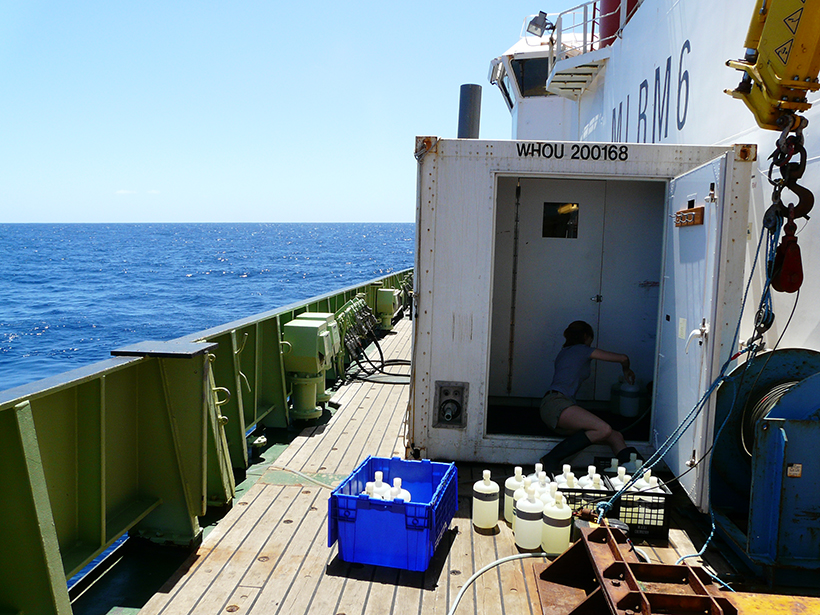Scientists have long tried to determine the role that biological processes play in sequestering atmospheric carbon in the deep ocean via the ocean’s biological carbon pump (BCP). In the upper sunlit layer of the ocean, the BCP transforms inorganic carbon into organic carbon via photosynthesis. Although much of this organic carbon is recycled (remineralized) back into inorganic carbon in the upper ocean, some fraction of this carbon is exported as a rain of sinking particles. This rain of particles consists of single cells, zooplankton fecal pellets, detritus, and aggregates of these materials. Remineralization continues as these particles sink through the water column; however, this carbon remains stored in the deep ocean as long as it is isolated from the atmosphere.

Naturally occurring radioisotopes are one tool that can be used to measure rates of export and remineralization. Compared to other techniques, radioisotopes can be sampled at higher resolution and thus are useful for highlighting the variability of these fluxes and pinpointing where they occur in the water column. Parent-daughter radioisotope pairs are chosen so that the half-life of the daughter aligns with timescales of interest in the BCP (weeks to seasons), the parent is relatively soluble in seawater, and the daughter is particle reactive, or “sticky.” For example, the size of the deviation of thorium-234 from its parent, uranium-238, tells us how much thorium-234 is removed from the surface ocean on particles (a deficit) or remineralized at depth (an excess; see Figure 1). The ratio of carbon to thorium-234 measured on sinking particles can then be used to extrapolate from thorium-234 fluxes to carbon fluxes.
In October 2016, the International Atomic Energy Agency (IAEA) convened a 2.5-day technical meeting at its Environment Laboratories in Monaco to discuss novel applications of radioisotope tracers to questions about the BCP. The group reviewed developments in the use of these tracers and how they might be used to address the effects of climate change on the BCP.
The baseline for these discussions was the well-established thorium-234 method and its more recent applications to study fluxes of not only carbon but also minerals, trace metals, and hydrocarbon pollutants. Much discussion focused on polonium-210 and thorium-228, two particle-reactive radioisotopes whose measurement in seawater has been honed through extensive work; however, these methods have been applied only selectively by a few research groups. Meeting attendees agreed that a wider application of these radioisotopes with longer half-lives in combination with thorium-234 is necessary to study particle fluxes in the BCP across multiple timescales.
A wider application of radioisotopes with longer half-lives is necessary to study particle fluxes in the biological carbon pump across multiple timescales.
Although this trio of tracers has been most commonly used to study particle export from the upper ocean, their application to remineralization of the sinking material has been limited. Meeting participants concurred that remineralization warrants further investigation with a multitracer approach. Determining the rate and depth range of this remineralization is important because of its tightly coupled feedback to atmospheric carbon dioxide. As the uncertainty of flux estimates from radioisotopes increases with depth, meeting attendees noted that polonium-210 and thorium-228 (both with longer half-lives than thorium-234) could better constrain the rate of remineralization.
Climate change will likely have a significant effect on the BCP, but changes in export may take decades to detect with current techniques. In the meantime, meeting participants agreed that the best approach is to maintain key ocean time series sites (e.g., the Bermuda Atlantic Time-Series Study, the Hawaii Ocean Time-Series, and the Porcupine Abyssal Plain Sustained Observatory) and to conduct process studies that include radioisotope measurements to determine the size and variability of BCP fluxes. Data resulting from such approaches can then inform models that project the effects of climate change.
The meeting underscored the importance of mining existing data, particularly as each new GEOTRACES transect contributes more radioisotope data.
The meeting underscored the importance of mining existing data, particularly as each new GEOTRACES transect contributes more radioisotope data. The group discussed possible collaborative outputs, such as a global database of carbon to thorium-234 ratios, and welcomes any interest from the wider community in contributing to these efforts.
Acknowledgments
Support and funding for Technical Meeting K4-TM-52877 was provided by the IAEA. The IAEA is grateful for the support provided to its Environment Laboratories by the government of the Principality of Monaco.
Author Information
Stephanie A. Morris (email: [email protected]) and Roberta L. Hansman, Environment Laboratories, International Atomic Energy Agency, Monaco; and Juan-Carlos Miquel, IAEA, Monaco, retired
Citation:
Morris, S. A.,Hansman, R. L., and Miquel, J.-C. (2017), Tracing carbon’s fate in the ocean, Eos, 98, https://doi.org/10.1029/2017EO076681. Published on 10 August 2017.
Text © 2017. The authors. CC BY 3.0
Except where otherwise noted, images are subject to copyright. Any reuse without express permission from the copyright owner is prohibited.

